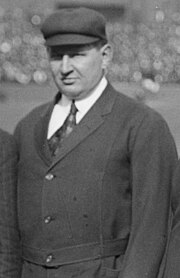Cy Rigler
| Cy Rigler | |
|---|---|

Rigler at the 1915 World Series
|
|
| Born |
May 16, 1882 Massillon, Ohio |
| Died | December 21, 1935 (aged 53) Philadelphia |
| Occupation | Umpire |
| Years active | 1906 – 1935 |
| Employer | National League |
| Height | 6 ft 1 in (185 cm) |
| Weight | 270 lb (122 kg) |
|
Football career |
|
| Position: | Tackle |
| Career history | |
|
|
| Career highlights and awards | |
|
|
Charles "Cy" Rigler (May 16, 1882 – December 21, 1935) was an American umpire in Major League Baseball who worked in the National League from 1906 to 1935. His total of 4,144 games ranked fourth in major league history when he retired, and his 2,468 games as a plate umpire still place him third behind his NL contemporaries Bill Klem (3,543) and Hank O'Day (2,710). Rigler is tied with O'Day for the second most World Series as an umpire (10), trailing only Klem's 18. Rigler has also been credited with instituting the practice of using arm signals when calling balls and strikes.
Born in Massillon, Ohio, Rigler never played baseball in his younger days, although he played pro football briefly in 1903 as a tackle for the Massillon Tigers. As a young man he worked as a machinist, and also as a police officer and fireman, and was encouraged toward work as an umpire because his thick build served well in quelling disputes on the field between the ironworkers who formed local teams. He advanced quickly in the field, working in the Central League in 1904 at age 22; in 1905 his excellent work was noted by scouts for NL president Harry Pulliam, and he was hired by the NL late in the 1906 season, becoming the youngest regular umpire in that league's history. His first major league game was on September 27, 1906, with the Brooklyn Dodgers visiting the Chicago Cubs; he became a member of the NL's regular staff in April 1907.
While working in the minor leagues in 1905, Rigler had initiated the practice of using arm signals to note balls and strikes, so that those in the outfield would more clearly follow the action; by the time he arrived in the majors, he discovered that the practice had become so widespread that it had preceded him there. Rigler joined the majors at a time when the use of one umpire in a game was still common; by the time his career ended, three umpires had become standard. His solid frame was a decided asset in an era in which players were decidedly more aggressive in their dealings with umpires; and umpires in the NL were not as clearly defended by league officials as those in the American League, although they were also given a free rein in resolving disputes and in allowing their own personalities to emerge.
...
Wikipedia
